Mode Analysis of Pt/LGS Surface Acoustic Wave Devices
Abstract
1. Introduction
2. Experimental
3. Modeling
4. Results and Discussion
4.1. Mode Analysis
4.2. Effect of Al2O3 Passivation Layer on Wave Modes
5. Conclusions
Author Contributions
Funding
Conflicts of Interest
References
- Greve, D.W.; Chin, T.L.; Peng, Z.; Ohodnicki, P.; Baltrus, J.; Oppenheim, I.J. Surface Acoustic Wave Devices for Harsh Environment Wireless Sensing. Sensors 2013, 13, 6910–6935. [Google Scholar] [CrossRef] [PubMed]
- Hornsteiner, J.; Born, E.; Fischerauer, G.; Riha, E. Surface Acoustic Wave Sensors for High-Temperature Applications. In Proceedings of the 1998 IEEE International Frequency Control Symposium, (Cat. No.98CH36165), Pasadena, CA, USA, 29 May 1998; pp. 615–620. [Google Scholar]
- Damjanovic, D. Materials for high temperature piezoelectric transducers. Curr. Opin. Solid State Mat. Sci. 1998, 3, 469–473. [Google Scholar] [CrossRef]
- Zhgoon, S.A.; Shvetsov, A.S.; Sakharov, S.A.; Elmazria, O. High-temperature SAW resonator sensors: Electrode design specifics. IEEE Trans. Ultrason. Ferroelectr. Freq. Control 2018, 65, 657–664. [Google Scholar] [CrossRef] [PubMed]
- Wang, S.-Q.; Harada, J.; Uda, S. A Wireless Surface Acoustic Wave Temperature Sensor Using Langasite as Substrate Material for High-Temperature Applications. Jpn. J. Appl. Phys. 2003, 42, 6124–6127. [Google Scholar] [CrossRef]
- Aubert, T.; Elmazria, O.; Assouar, M.B. Wireless and Batteryless Surface Acoustic Wave Sensors for High Temperature Environments. In Proceedings of the 2009 9th International Conference on Electronic Measurement Instruments, Beijing, China, 16–19 August 2009; pp. 2890–2898. [Google Scholar]
- Ernst, D.; Brachmann, E.; Menzel, S.; Bock, K. Wire Bonding of Surface Acoustic Wave (SAW) Sensors for High Temperature Applications. In Proceedings of the 2018 7th Electronic System-Integration Technology Conference (ESTC), Dresden, Germany, 18–21 September 2018; pp. 1–5. [Google Scholar]
- Liu, X.; Peng, B.; Zhang, W.; Zhu, J.; Liu, X.; Wei, M. Improvement of High-Temperature Stability of Al2O3/Pt/ZnO/Al2O3 Film Electrode for SAW Devices by Using Al2O3 Barrier Layer. Materials 2017, 10, 1377. [Google Scholar] [CrossRef]
- Maskay, A.; Ayes, A.; Lad, R.J.; Pereira da Cunha, M. Stability of Pt/Al2O3-Based Electrode Langasite SAW Sensors with Al2O3 Capping Layer and Yttria-Stabilized Zirconia Sensing Layer. In Proceedings of the 2017 IEEE International Ultrasonics Symposium (IUS), Washington, DC, USA, 6–9 September 2017; pp. 1–4. [Google Scholar]
- Zheng, P.; Chin, T.-L.; Greve, D.W.; Oppenheim, I.J.; Cao, L. Pulse-Mode Temperature Sensing with Langasite SAW Devices. In Proceedings of the Frequency Control Symposium (FCS), 2010 IEEE International, Newport Beach, CA, USA, 1–4 June 2010; pp. 297–300. [Google Scholar]
- Schulz, M.; Mayer, E.; Shrena, I.; Eisele, D.; Schmitt, M.; Reindl, L.M.; Fritze, H. Correlation of BAW and SAW properties of langasite at elevated temperatures. J. Sens. Sens. Syst. 2015, 4, 331–340. [Google Scholar] [CrossRef]
- Mayer, E.; Eisele, D.; Reindl, L.M.; Plessky, V.P.; Richter, D.; Fritze, H. SAW parameters for langasite at high temperatures. In Proceedings of the 2011 IEEE International Ultrasonics Symposium, Orlando, FL, USA, 18–21 October 2011; pp. 2069–2073. [Google Scholar]
- Maskay, A.; Pereira da Cunha, M. High-temperature static strain langasite SAWR sensor: Temperature compensation and numerical calibration for direct strain reading. Sens. Actuators A Phys. 2017, 259, 34–43. [Google Scholar] [CrossRef]
- Thiele, J.A.; da Cunha, M.P. High temperature LGS SAW gas sensor. Sens. Actuators B Chem. 2006, 113, 816–822. [Google Scholar] [CrossRef]
- Da Cunha, M.P.; Lad, R.J.; Davulis, P.; Canabal, A.; Moonlight, T.; Moulzolf, S.; Frankel, D.J.; Pollard, T.; McCann, D.; Dudzik, E.; et al. Wireless Acoustic Wave Sensors and Systems for Harsh Environment Applications. In Proceedings of the 2011 IEEE Topical Conference on Wireless Sensors and Sensor Networks, Phoenix, AZ, USA, 16–19 January 2011; pp. 41–44. [Google Scholar]
- Xu, H.; Dong, S.; Xuan, W.; Farooq, U.; Huang, S.; Li, M.; Wu, T.; Jin, H.; Wang, X.; Luo, J. Flexible surface acoustic wave strain sensor based on single crystalline LiNbO3 thin film. Appl. Phys. Lett. 2018, 112, 093502. [Google Scholar] [CrossRef]
- Xu, H.; Cao, Z.; Dong, S.; Chen, J.; Xuan, W.; Cheng, W.; Huang, S.; Shi, L.; Liu, S.; Farooq, U. Flexible dual-mode surface acoustic wave strain sensor based on crystalline LiNbO3 thin film. J. Micromech. Microeng. 2018, 29, 025003. [Google Scholar] [CrossRef]
- Mu, X.; Kropelnicki, P.; Wang, Y.; Randles, A.B.; Chuan Chai, K.T.; Cai, H.; Gu, Y.D. Dual mode acoustic wave sensor for precise pressure reading. Appl. Phys. Lett. 2014, 105, 113507. [Google Scholar] [CrossRef]
- Naumenko, N.F. Analysis of interaction between two SAW modes in Pt grating on langasite cut (0°, 138.5°, 26.6°). IEEE Trans. Ultrason. Ferroelect. Freq. Contr. 2011, 58, 2370–2377. [Google Scholar] [CrossRef] [PubMed]
- Naumenko, N. Effect of anisotropy on SAW behavior in LGS orientation with Euler angles (0°, 22°, 90°). In Proceedings of the 2011 IEEE International Ultrasonics Symposium, Orlando, FL, USA, 18–21 October 2011; pp. 2086–2089. [Google Scholar]
- Bardong, J.; Aubert, T.; Naumenko, N.; Bruckner, G.; Salzmann, S.; Reindl, L.M. Experimental and theoretical investigations of some useful langasite cuts for high-temperature SAW applications. IEEE Trans. Ultrason. Ferroelect. Freq. Contr. 2013, 60, 814–823. [Google Scholar] [CrossRef] [PubMed]
- Sakharov, S.; Naumenko, N.; Zabelin, A.; Zhgoon, S. Characterization of langasite for application in high temperature SAW sensors. In Proceedings of the 2011 IEEE International Ultrasonics Symposium, Orlando, FL, USA, 18–21 October 2011; pp. 2289–2292. [Google Scholar]
- Li, L.; Peng, B. Temperature-Dependent Characteristics of Surface Acoustic Wave Resonators Deposited on (0°, 138.5°, ψ) Langasite Cuts. IEEE Sens. J. 2019, 19, 1388–1391. [Google Scholar] [CrossRef]
- Fachberger, R.; Bruckner, G.; Hauser, R.; Ruppel, C.; Biniasch, J.; Reindl, L. Properties of radio frequency rayleigh waves on langasite at elevated temperatures. In Proceedings of the IEEE Ultrasonics Symposium, Montreal, QC, Canada, 23–27 August 2004; Volume 2, pp. 1223–1226. [Google Scholar]
- Preiss, E.M.; Krauss, A.; Seidel, H. Sputtered Pt electrode structures with smoothly tapered edges by bi-layer resist lift-off. Thin Solid Films 2015, 597, 158–164. [Google Scholar] [CrossRef]
- Auld, B.A. Acoustic Waves and Fields in Solids; Wiley and Sons: New York, NY, USA, 1973; Volume 1. [Google Scholar]
- Campbell, J.J.; Jones, W.R. A method for estimating optimal crystal cuts and propagation directions for excitation of piezoelectric surface waves. IEEE Trans. Sonics Ultrason. 1968, 15, 209–217. [Google Scholar] [CrossRef]
- Sakharov, S.; Senushencov, P.; Medvedev, A.; Pisarevsky, Y. New data on temperature stability and acoustical losses of langasite crystals. In Proceedings of the 1995 IEEE International Frequency Control Symposium (49th Annual Symposium), San Francisco, CA, USA, 31 May–2 June 1995; pp. 647–652. [Google Scholar]
- Zheng, P.; Greve, D.W.; Oppenheim, I.J. Langasite surface acoustic wave gas sensors: Modeling and verification. IEEE Trans. Ultrason. Ferroelect. Freq. Control 2013, 60, 579–586. [Google Scholar] [CrossRef]
- Naumenko, N.; Solie, L. Optimal cuts of langasite, La/sub 3/Ga/sub 5/SiO/sub 14/ for SAW devices. IEEE Trans. Ultrason. Ferroelect. Freq. Control 2001, 48, 530–537. [Google Scholar] [CrossRef]
- Takai, T.; Iwamoto, H.; Takamine, Y.; Yamazaki, H.; Fuyutsume, T.; Kyoya, H.; Nakao, T.; Kando, H.; Hiramoto, M.; Toi, T.; et al. High-Performance SAW Resonator on New Multilayered Substrate Using LiTaO3 Crystal. IEEE Trans. Ultrason. Ferroelect. Freq. Control 2017, 64, 1382–1389. [Google Scholar] [CrossRef]
- Takai, T.; Iwamoto, H.; Takamine, Y.; Yamazaki, H.; Fuyutsume, T.; Kyoya, H.; Nakao, T.; Kando, H.; Hiramoto, M.; Toi, T.; et al. Incredible High Performance SAW Resonator on Novel Multi-Layerd Substrate. In Proceedings of the 2016 IEEE International Ultrasonics Symposium (IUS), Tours, France, 18–21 September 2016; pp. 1–4. [Google Scholar]
- Bergmann, L.; Hatfield, H. Ultrasonics and Their Scientific and Technical Applications; John Wiley Sons: New York, NY, USA, 1948. [Google Scholar]
- Aubert, T.; Sarry, F.; Elmazria, O.; Assouar, B.; Bouvot, L.; Nicolay, P. High Temperature Pt/LGS SAW Sensor: From Theory to Experiment. In Proceedings of the 2011 IEEE SENSORS Proceedings, Limerick, Ireland, 28–31 October 2011; pp. 1632–1635. [Google Scholar]
- Dühring, M.B.; Laude, V.; Khelif, A. Energy storage and dispersion of surface acoustic waves trapped in a periodic array of mechanical resonators. J. Appl. Phys. 2009, 105, 093504. [Google Scholar] [CrossRef]
- Shu, L.; Peng, B.; Yang, Z.; Wang, R.; Deng, S.; Liu, X. High-Temperature SAW Wireless Strain Sensor with Langasite. Sensors 2015, 15, 28531–28542. [Google Scholar] [CrossRef] [PubMed]
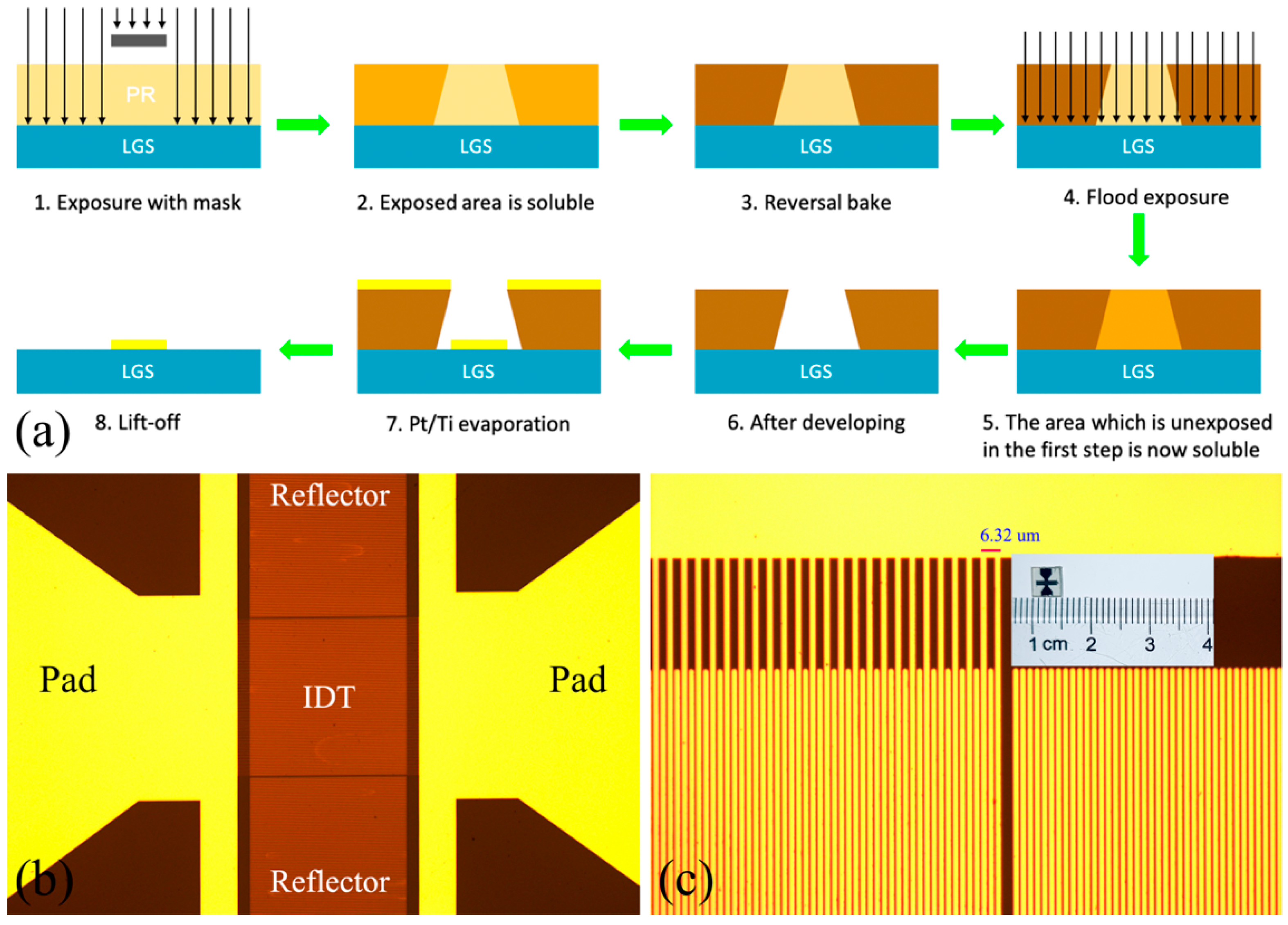
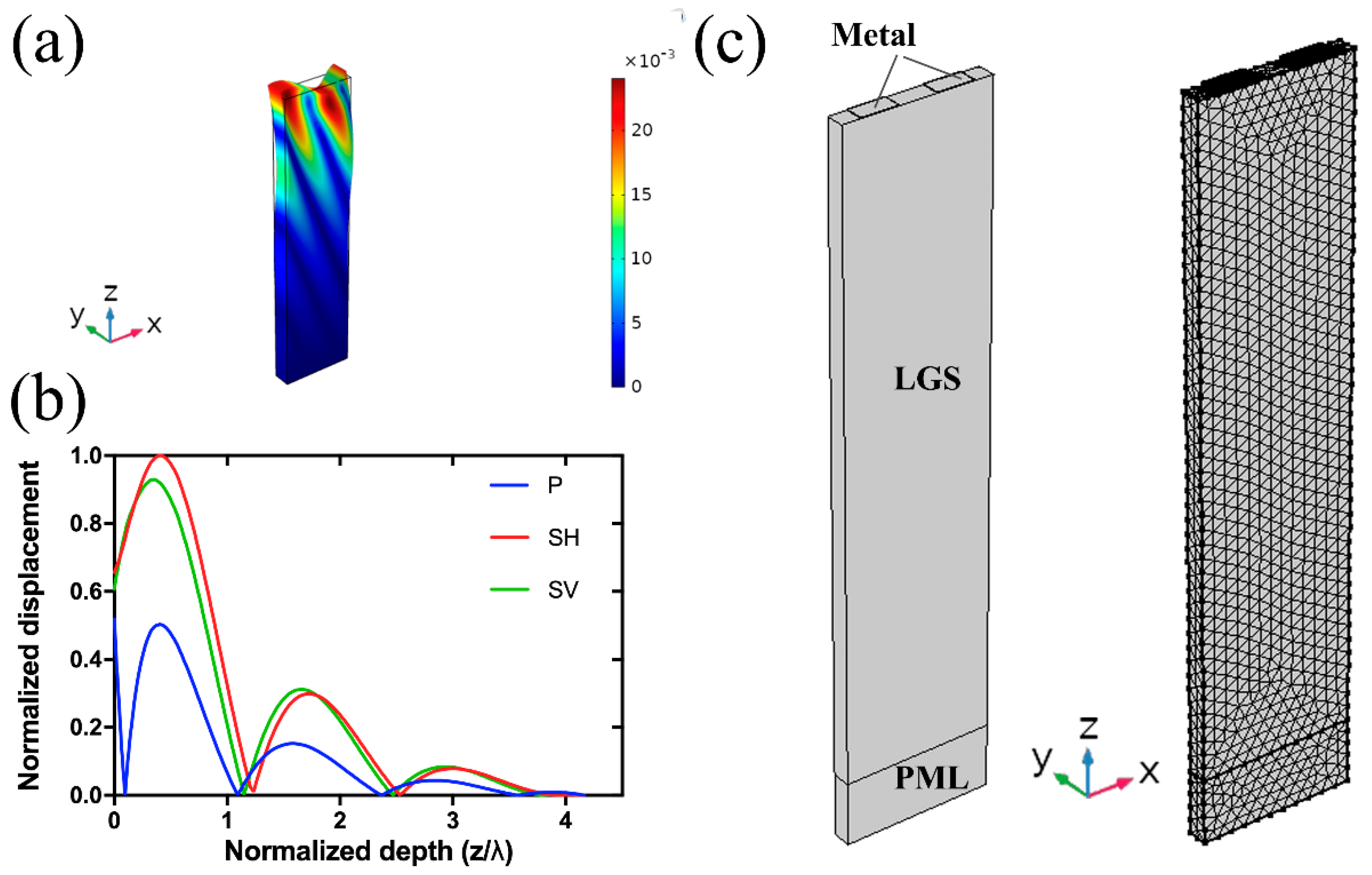
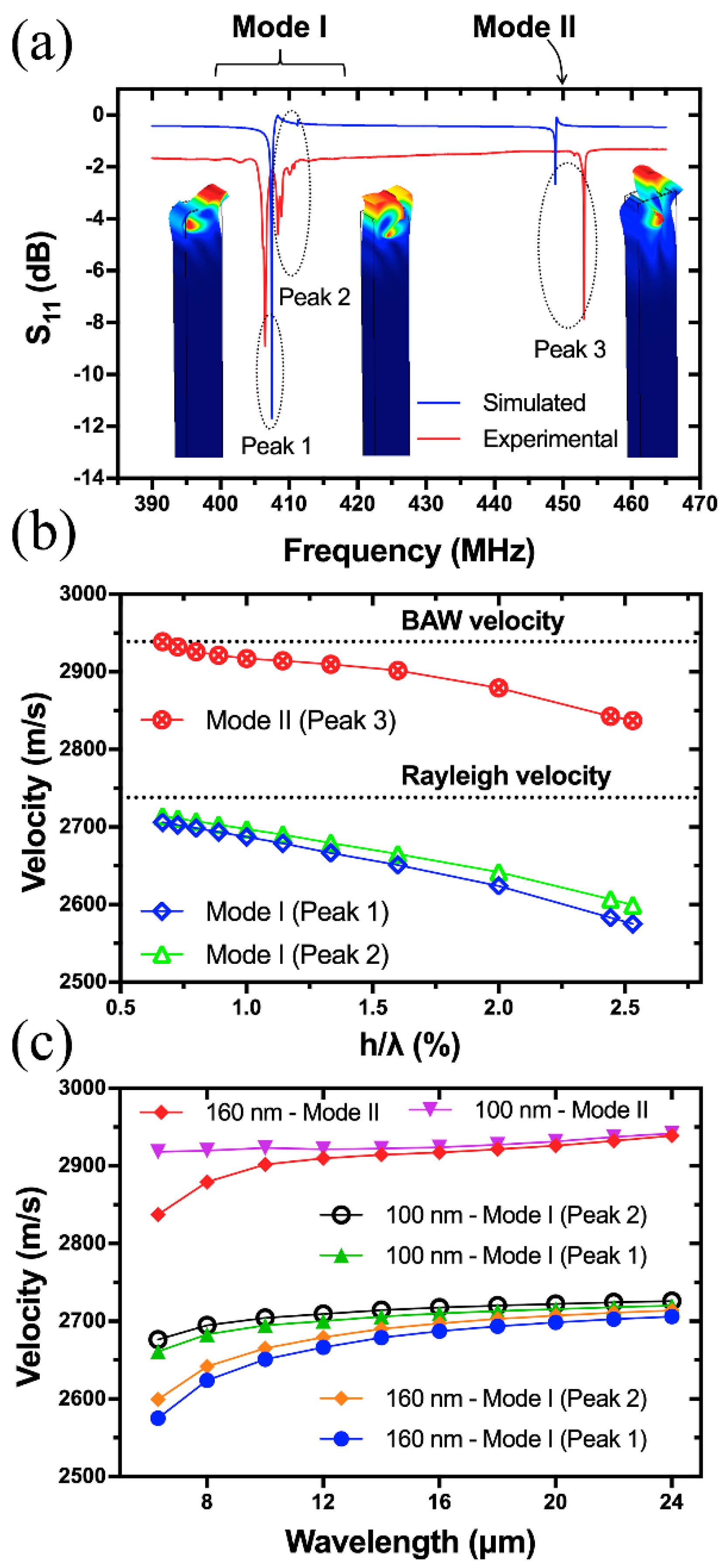
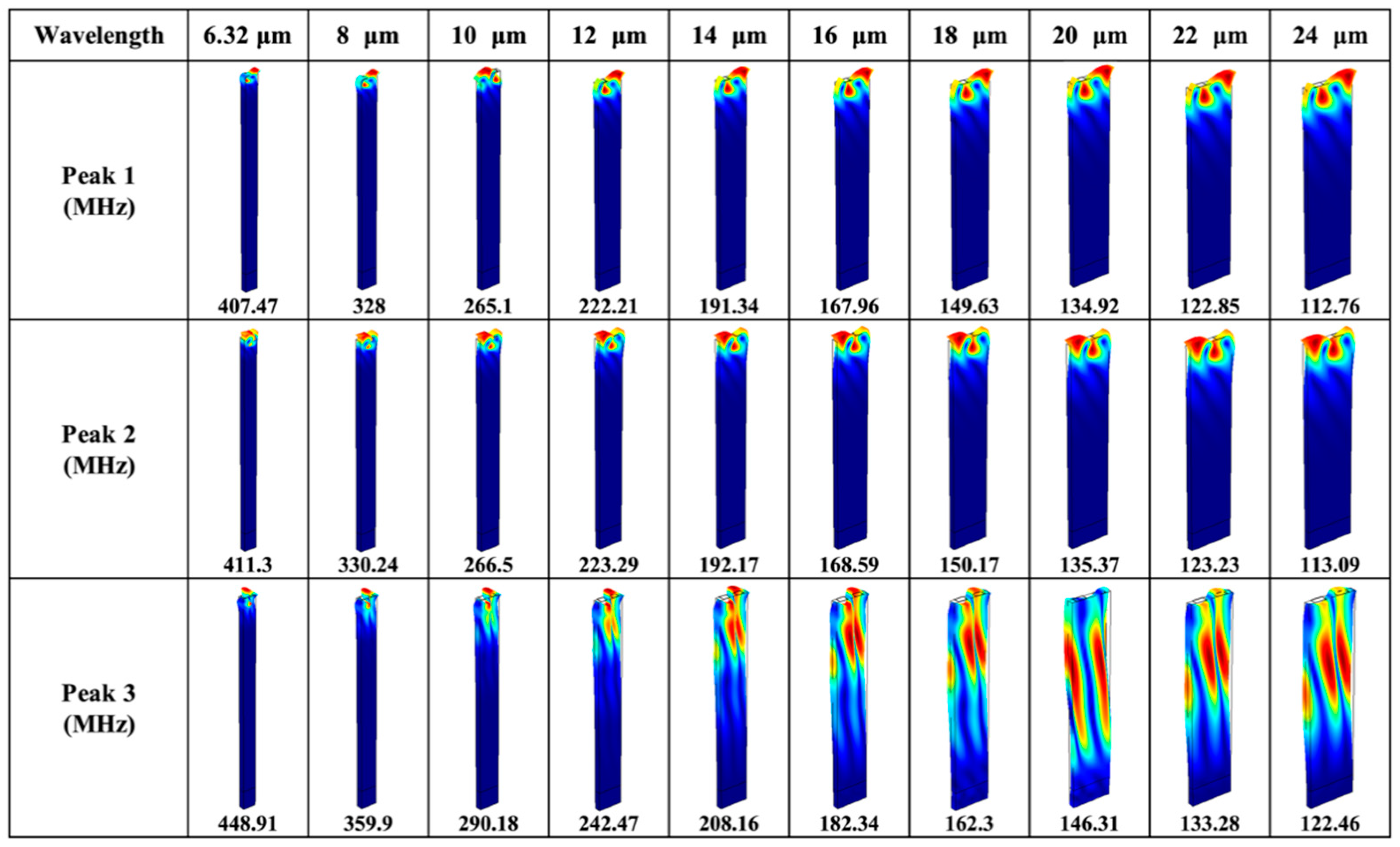
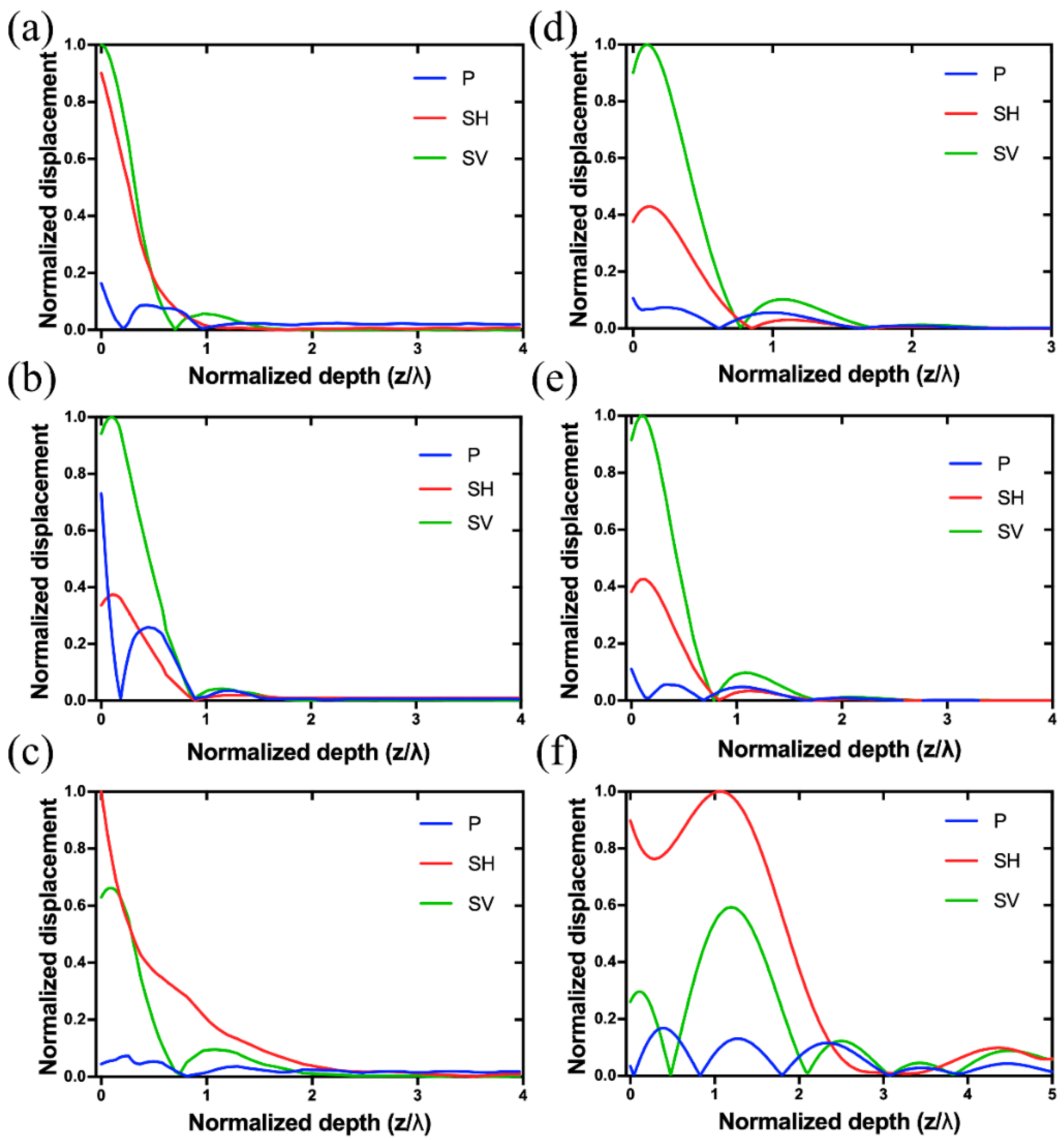
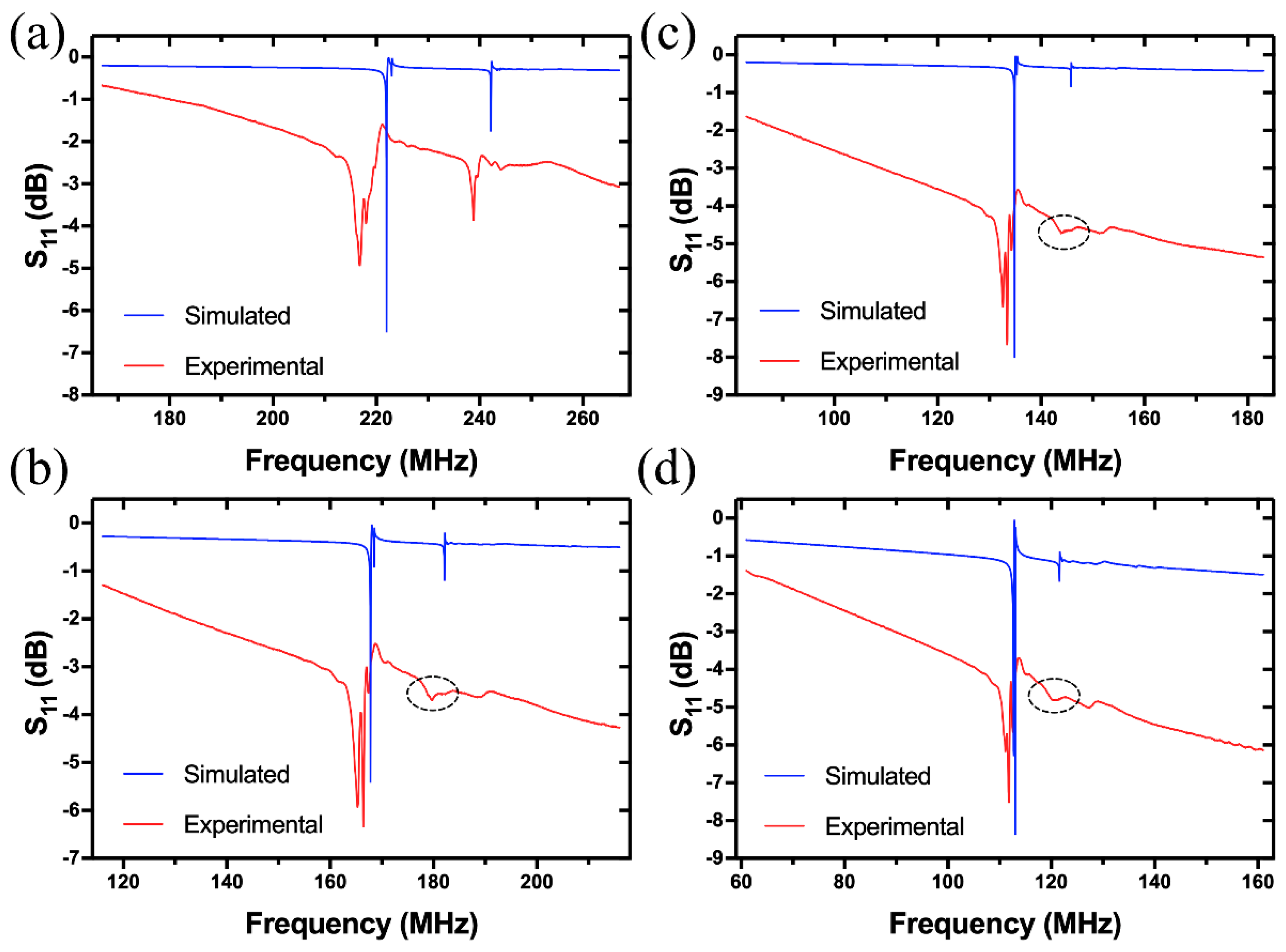
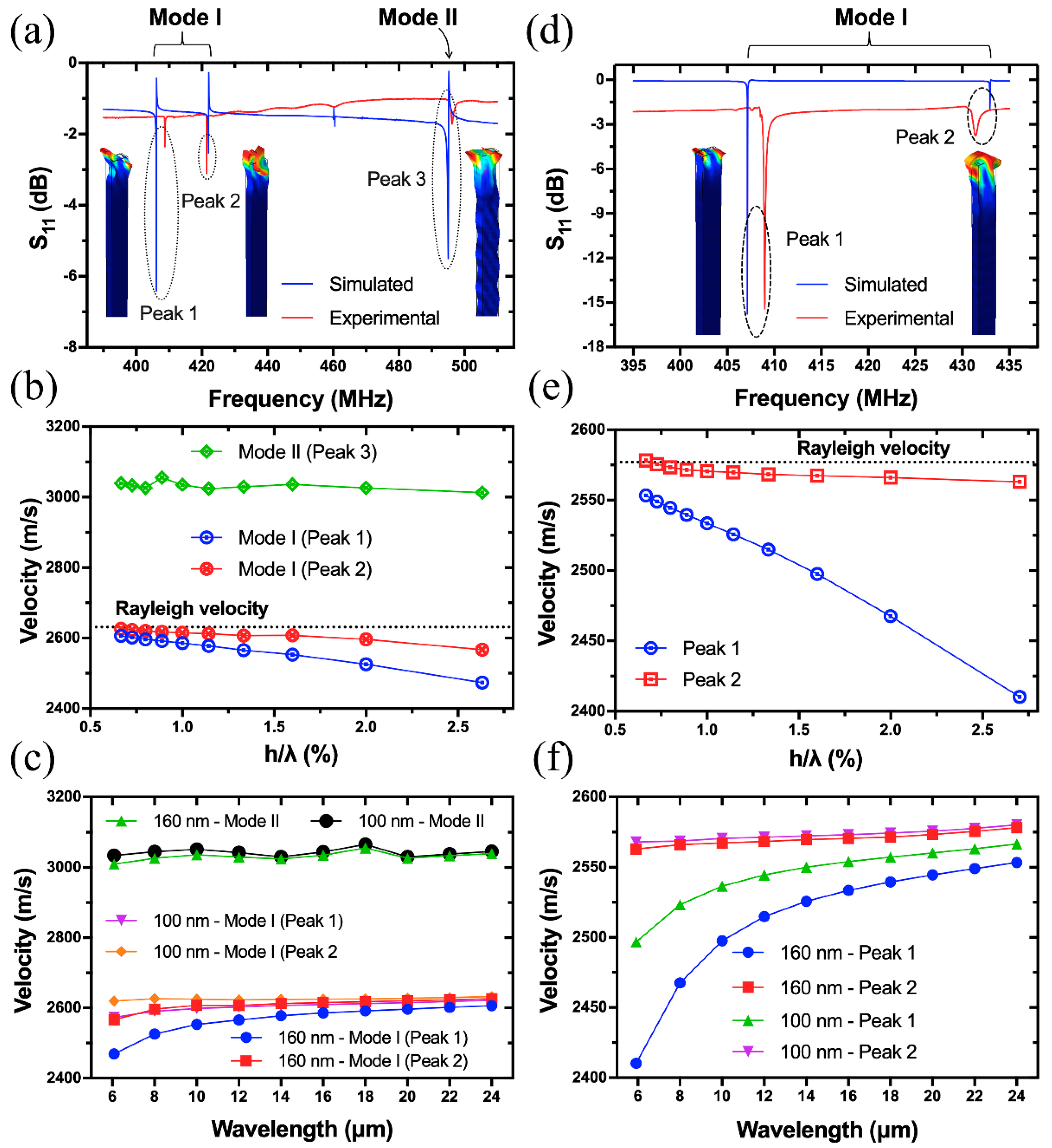
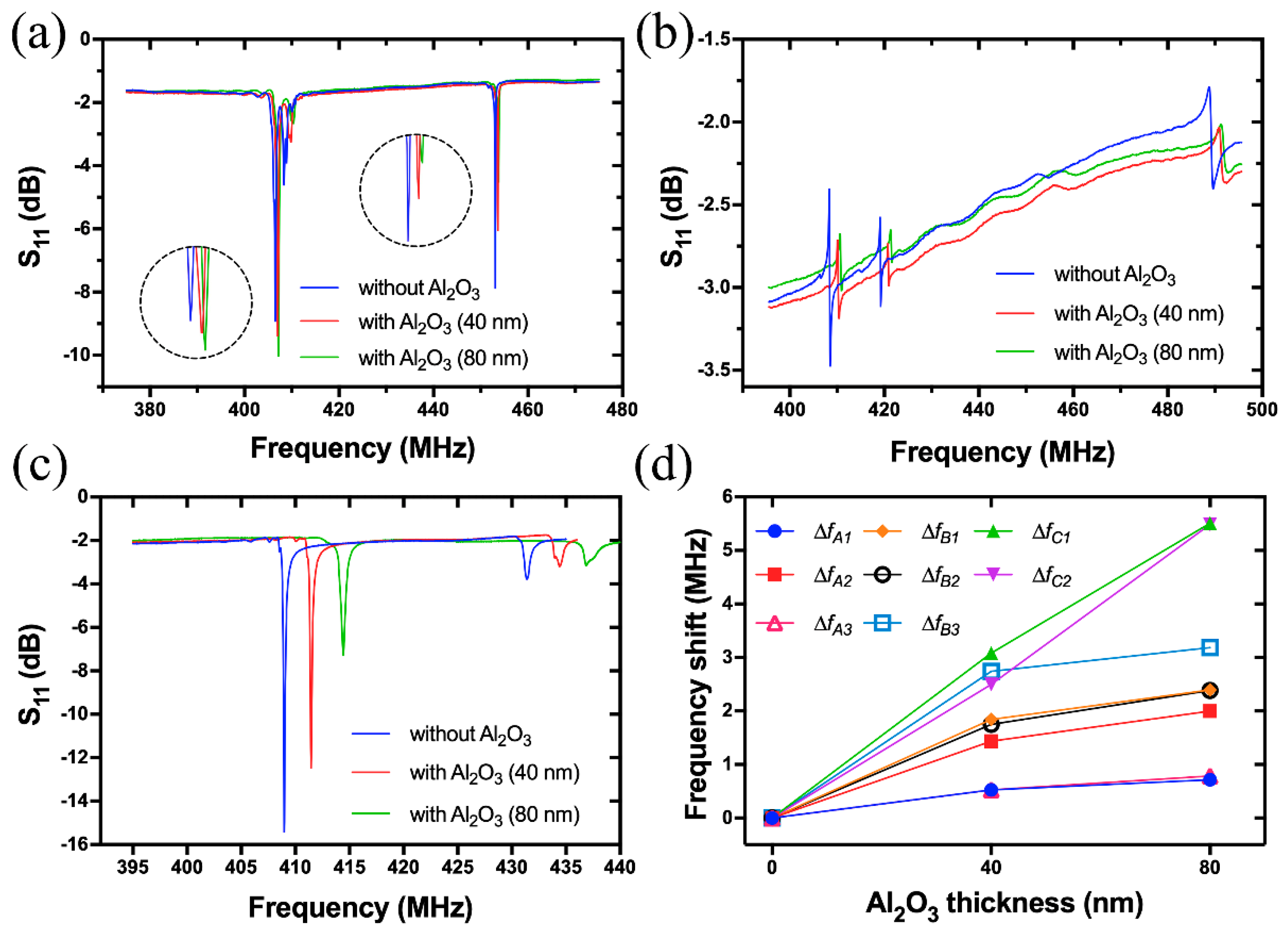
| Euler Angle | Numerical Computation | 2D Simulation | 3D Simulation | Maximum SH Disp. | |||
|---|---|---|---|---|---|---|---|
| (0, 138.5, 27) | 2743.0 | 2738.4 | 2815.9 | 2814.5 | 2755.7 | 2750.5 | 2.5 |
| (0, 138.5, 117) | 2631.0 | 2630.6 | 2889.2 | 2888.8 | 2638.2 | 2637.8 | 14 |
| (0, 138.5, 72) | 2577.0 | 2575.4 | 2919.7 | 2919.5 | 2577.2 | 2575.7 | 6 |
Publisher’s Note: MDPI stays neutral with regard to jurisdictional claims in published maps and institutional affiliations. |
© 2020 by the authors. Licensee MDPI, Basel, Switzerland. This article is an open access article distributed under the terms and conditions of the Creative Commons Attribution (CC BY) license (http://creativecommons.org/licenses/by/4.0/).
Share and Cite
Xu, H.; Jin, H.; Dong, S.; Song, X.; Chen, J.; Xuan, W.; Huang, S.; Shi, L.; Luo, J. Mode Analysis of Pt/LGS Surface Acoustic Wave Devices. Sensors 2020, 20, 7111. https://doi.org/10.3390/s20247111
Xu H, Jin H, Dong S, Song X, Chen J, Xuan W, Huang S, Shi L, Luo J. Mode Analysis of Pt/LGS Surface Acoustic Wave Devices. Sensors. 2020; 20(24):7111. https://doi.org/10.3390/s20247111
Chicago/Turabian StyleXu, Hongsheng, Hao Jin, Shurong Dong, Xinyu Song, Jinkai Chen, Weipeng Xuan, Shuyi Huang, Lin Shi, and Jikui Luo. 2020. "Mode Analysis of Pt/LGS Surface Acoustic Wave Devices" Sensors 20, no. 24: 7111. https://doi.org/10.3390/s20247111
APA StyleXu, H., Jin, H., Dong, S., Song, X., Chen, J., Xuan, W., Huang, S., Shi, L., & Luo, J. (2020). Mode Analysis of Pt/LGS Surface Acoustic Wave Devices. Sensors, 20(24), 7111. https://doi.org/10.3390/s20247111











